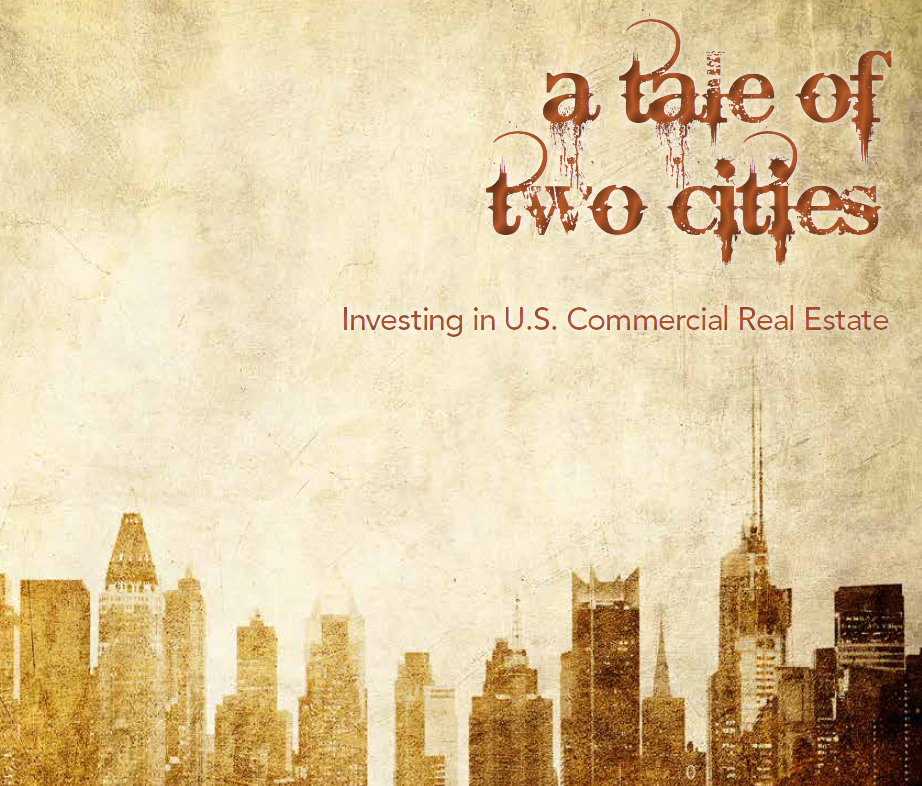We typically, actually almost exclusively, focus on residential real estate in the Economics Center. But, today it’s time to broaden our horizons. Focusing on residential real estate misses all the shops, restaurants, warehouses, hospitals and offices like the one I am sitting in right now writing this. In short, focusing on residential real estate misses where we spend much of our time when we are not at home. According to the Federal Reserve, outstanding commercial real estate debt is over $3.6 trillion as of the end of 2015, so it’s time we started paying attention.
“There are two demand sources that are playing predominantly influential roles in these commercial real estate markets today – foreign investors and millennials, yet each for different underlying economic reasons.”
Earlier this month, my colleague, Linda Isaacson, released a paper, A Tale of Two “commercial real estate asset” Cities, which evaluates the differences among cities that drive commercial real estate investment. The paper distinguishes between gateway and non-gateway cities, the influence of central business district (CBD) walkability on commercial asset price growth and the surprising investor interest in some distressed cities – think Detroit.
Below is a side bar I authored for the paper, called a Tale of Two Economies. I hope you enjoy our first foray into commercial real estate and encourage you to read the full white paper.
A Tale of Two Economies
The well-documented demand for commercial real estate in gateway versus non-gateway cities is driven by very different forces. In particular, there are two demand sources that are playing predominantly influential roles in these commercial real estate markets today — foreign investors and millennials, yet each for different underlying economic reasons.
Foreign investors, as has been shown, have particular interest in commercial real estate assets in gateway cities such as New York, San Francisco, and Chicago. Why is real estate so attractive to foreign investors in these markets and why have they effectively bid prices ever higher and driven yields ever lower? First, U.S. commercial real estate is viewed, among all global investment opportunities, to be a relatively safe asset class. Late last year, the IMF published its world economic outlook in which it outlined the state of economic affairs across the globe. Slowing growth, falling oil and commodity prices, a faster slowdown in China’s growth rate and increased geopolitical tension are all contributing to the increased attractiveness of U.S. commercial real estate assets. Furthermore, while the dollar has strengthened recently relative to other countries, over the last few years it has been weak. This directly and beneficially influences the affordability of U.S. commercial real estate assets for foreign buyers.
Domestic millennial first-time buyers are driving commercial real estate demand in many secondary markets like Austin, Denver and San Jose as they seek attractive job opportunities found in those locations. Strong and growing labor markets drawing well-educated and highly paid talent to these markets is causing economic expansion. While the direct demand for amenity-rich multifamily housing is driving up prices, other commercial real estate asset classes are also benefiting from the broad economic impact that in-migration causes in a local economy. The renter millennial needs to shop, eat, and play somewhere, which helps to increase demand across commercial and real estate sectors.
Whether a gateway city or secondary market, healthy economies and strong real estate demand are fundamentally driven by the underlying labor market. In particular, real estate demand benefits from labor markets that provide high paying jobs, which usually require more education. New York and San Jose are no exception. In fact, the share of households in New York where the head-of-household has a bachelor’s degree or higher has increased from 34 percent in 2001 to 43 percent in 2015, and as a result median household income has increased 36 percent. In the secondary market of San Jose the share of households with a bachelor’s degree or higher has increased from 49 percent in 2001 to 54 percent in 2015, and as a result median household income has increased 32 percent.
Cities are attractive if they offer good job opportunities, strong transportation infrastructure and walkable lifestyles. While these attractive markets might appeal to a diverse set of buyers, foreign investors in gateway cities or young millennials in secondary cities, the tale of economic outcomes are quite similar. High demand for commercial real estate is driving up prices and reducing cap rates. Foreign investors may lessen their demand as the dollar strengthens, but the influence of Millennials and their migration to “innovation hubs”, will only grow stronger in the coming years.




